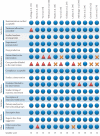Classic Chinese Acupuncture versus Different Types of Control Groups for the Treatment of Chronic Pain: Review of Randomized Controlled Trials (2000-2018)
- PMID: 31885655
- PMCID: PMC6914898
- DOI: 10.1155/2019/6283912
Classic Chinese Acupuncture versus Different Types of Control Groups for the Treatment of Chronic Pain: Review of Randomized Controlled Trials (2000-2018)
Abstract
Objective: To review the effectiveness of classic Chinese acupuncture in the treatment of chronic pain by comparing treatment groups with different types of control groups in accordance with the newly published guidelines for systematic reviews.
Methods: We searched EMBASE, PubMed, and the Cochrane Central Register of Controlled Trials databases from 2000 to 2018. We included randomized controlled trials that included acupuncture as the sole treatment or as an adjunctive treatment for chronic pain. The outcome was pain intensity measured by the visual analogue scale (VAS), Western Ontario and McMaster Universities Osteoarthritis Index (WOMAC) pain subscale, 11-point numeric rating scale (NRS), and other tools. Two researchers conducted the study selection, data extraction, and quality assessment processes independently. Disagreements were solved by discussion and reanalysis of the data. The quality of all included studies was evaluated using the CBNG (the Cochrane Back and Neck Group) and the STRICTA (Standards for Reporting Interventions in Controlled Trials of Acupuncture) checklists.
Results: Sixty-one studies were fully analyzed and ranked based on the newest STRICTA and CBNG standards. We found good evidence that receiving acupuncture is better than not receiving treatment or being placed on a waiting list and reasonable evidence that it is better than conventional or usual care. Limited evidence was found regarding placebo treatments that involve the expectation of needling (real or fake).
Conclusion: Sham acupuncture may not be appropriate as a control intervention for assessing the effectiveness of acupuncture. Acupuncture effectiveness in controlling chronic pain is still limited due to the low quality of the studies published.
Copyright © 2019 Yan-Jiao Chen et al.
Conflict of interest statement
The authors declare that they have no conflicts of interest.
Figures
Similar articles
-
Acupuncture versus Various Control Treatments in the Treatment of Migraine: A Review of Randomized Controlled Trials from the Past 10 Years.J Pain Res. 2020 Aug 12;13:2033-2064. doi: 10.2147/JPR.S259390. eCollection 2020. J Pain Res. 2020. PMID: 32884332 Free PMC article. Review.
-
Acupuncture for chronic knee pain: a protocol for an updated systematic review.BMJ Open. 2016 Feb 24;6(2):e008027. doi: 10.1136/bmjopen-2015-008027. BMJ Open. 2016. PMID: 26911581 Free PMC article.
-
Complementary and alternative therapies for back pain II.Evid Rep Technol Assess (Full Rep). 2010 Oct;(194):1-764. Evid Rep Technol Assess (Full Rep). 2010. PMID: 23126534 Free PMC article. Review.
-
The effectiveness of acupuncture for chronic pain with depression: A systematic review protocol.Medicine (Baltimore). 2017 Nov;96(47):e8800. doi: 10.1097/MD.0000000000008800. Medicine (Baltimore). 2017. PMID: 29381981 Free PMC article.
-
Acupuncture and related interventions for the treatment of symptoms associated with carpal tunnel syndrome.Cochrane Database Syst Rev. 2018 Dec 2;12(12):CD011215. doi: 10.1002/14651858.CD011215.pub2. Cochrane Database Syst Rev. 2018. PMID: 30521680 Free PMC article.
Cited by
-
Acupuncture versus Various Control Treatments in the Treatment of Migraine: A Review of Randomized Controlled Trials from the Past 10 Years.J Pain Res. 2020 Aug 12;13:2033-2064. doi: 10.2147/JPR.S259390. eCollection 2020. J Pain Res. 2020. PMID: 32884332 Free PMC article. Review.
-
Effect of acupuncture on pain and substance P levels in middle-aged women with chronic neck pain.Front Neurol. 2023 Oct 19;14:1267952. doi: 10.3389/fneur.2023.1267952. eCollection 2023. Front Neurol. 2023. PMID: 37928143 Free PMC article.
-
Acupuncture (superficial dry-needling) as a treatment for chronic postherpetic neuralgia - a randomized clinical trial.Br J Pain. 2022 Feb;16(1):96-108. doi: 10.1177/20494637211023075. Epub 2021 Jun 13. Br J Pain. 2022. PMID: 35111318 Free PMC article.
-
A Retrospective Study on Chronic Pelvic Pain Treated with Traditional Chinese Medicine Combined Therapy: 179 Cases (2016-2018).J Pain Res. 2021 Oct 14;14:3239-3250. doi: 10.2147/JPR.S329317. eCollection 2021. J Pain Res. 2021. PMID: 34703299 Free PMC article.
-
Placebo response varies between different types of sham acupuncture: A randomized double-blind trial in neck pain patients.Eur J Pain. 2022 May;26(5):1006-1020. doi: 10.1002/ejp.1924. Epub 2022 Feb 19. Eur J Pain. 2022. PMID: 35129852 Free PMC article. Clinical Trial.
References
-
- Merskey H., Bogduk N. Classification of Chronic Pain, IASP Task Force on Taxonomy. 2nd. Washington, DC, USA: IASP Press; 1994.
-
- IPRCC. National Pain Strategy: A Comprehensive Population Health-Level Strategy for Pain. Washington, DC, USA: N. I. o.H. US Department of Health and Human Services; 2016.
Publication types
LinkOut - more resources
Full Text Sources



 stands for YES,
stands for YES,  stands for NO,…
stands for NO,…  stands for UNKNOWN.
stands for UNKNOWN.